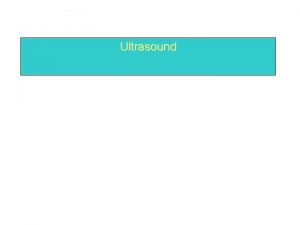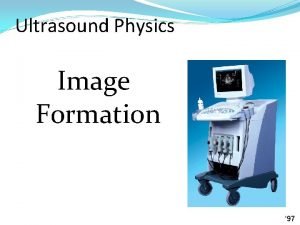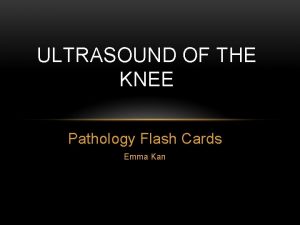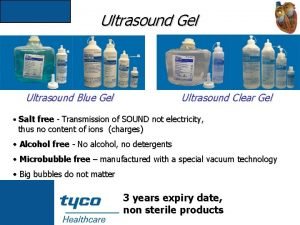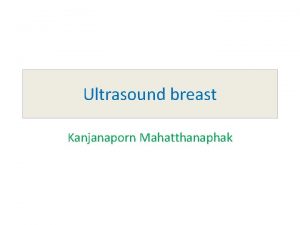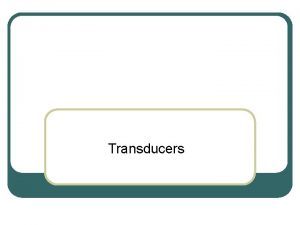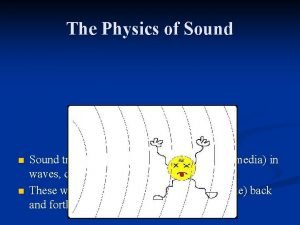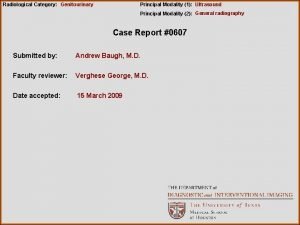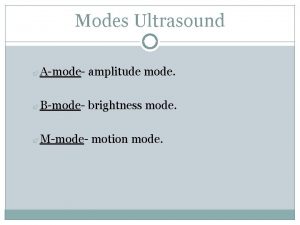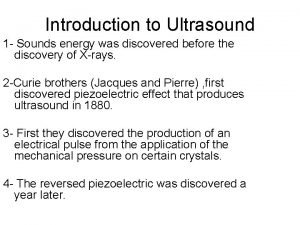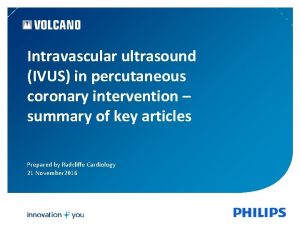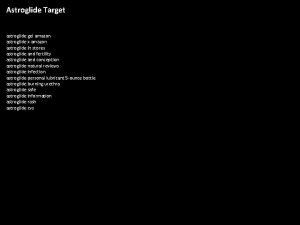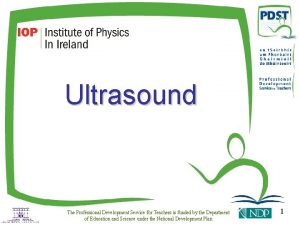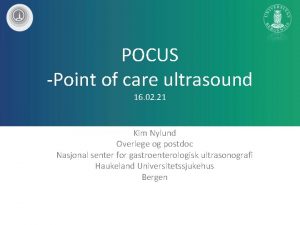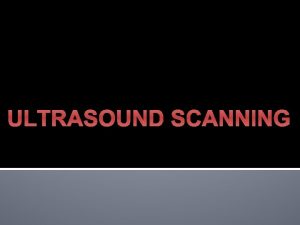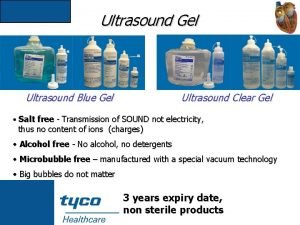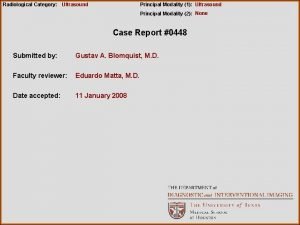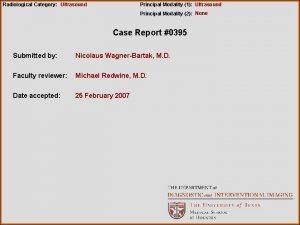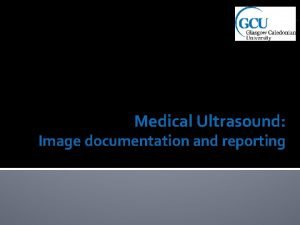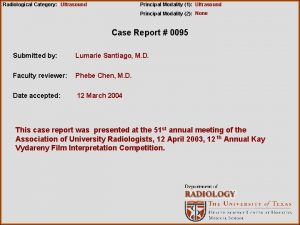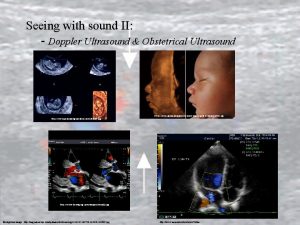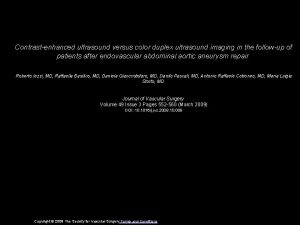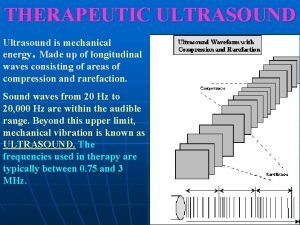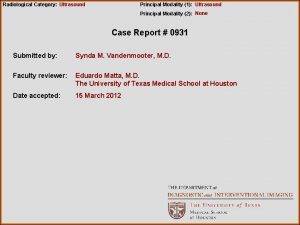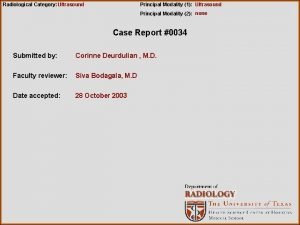An Intro To POCUS Point of Care Ultrasound




































- Slides: 36

An Intro To POCUS (Point of Care Ultrasound for Family Medicine)

Road Map • Lectures with breakout components • • POCUS and US Basics (15 min) Hands-On Ultrasound Time (15 min) FAST (15 min) Hands-On Ultrasound Time (40 min) • Evaluation (5 min)

Objectives • Gain confidence using US as a point-of-care tool • Demonstrate the basics of using an US machine to one of your colleagues • Preform an e. FAST exam on one of your friends

Shout to Contra Costa Thanks Guys!

Why POCUS? • Utilization by US is becoming more ubiquitous • Family Doctors are already using ultrasound • Underserved component to POCUS has been overlooked

The POCUS Philosophy • Quick bedside answers to focused questions • No diagnosis or procedure solely dependent on US • aid to diagnosis like an EKG or CXR or as an adjunct to doing a procedure • Bedside US is an extension of the PE STFM POCUS 2017

My Vision • Yearly POCUS training during resident school • Twice Monthly Trainings on the IPS • Fall 2017 Faculty Training • Expanded Yearly Resident Training? • More robust US applications in clinic?


The Basics • Transmission • Probes • Orientation • Knobs and Buttons




Orientation • US Machine should be on the patient’s right • Indicator should point to • Head (longitudinal) • Patient’s right side (transverse) • Indicator on the screen should match the probe

• Modes • 2 D • Color • M Mode • Settings • Software changes the image based on the setting • Depth • Indicators on the side of the image • Gain • Brightness of the image • Near and far gain

Your Mission (15 min): • US Probes – What are they for? • Settings • Orientation of Machine and Indicators • Gain • Depth • If there’s time… try M Mode • Normal Lung VS Pneumothorax


The e. FAST Exam Focused Assessment with Sonography in Trauma

Santa Rosa, NM • 35 yo male headed to the Pecos River in VW Van • Head on collision with an elk • Exam – • HR 120, BP 120/70, RR 25, O 2 90% • Contusions to the left flank • Decreased left sided BS

FAST Overview • Clinical Questions • Relevant windows of the fast exam • Normal and Abnormal

2 questions • Is there fluid in the abdomen? • Is there fluid in the pericardium?

Windows… Use a Phase Array or Curvelinear Probe 1. Hepatorenal (Morison’s Pouch) 2. Subcostal 3. Perisplenic 4. Suprapubic

Hepatorenal (Morison’s Pouch) • Longitudinal plane • Axillary Line • 7 -9 th intercostal space

Morison’s Pouch

Perisplenic Recess • Posterior axillary line • 5 -7 th intercostal space • “knuckles to the bed”

Perisplenic

Suprapubic • Transverse View • Low in the pelvis • Look for fluid behind the bladder.

Longitudinal View • More sensitive for free fluid

Subxiphoid • Probe marker to right • Under the xiphiod process • Look to the left. • Real time subxiphoid view • Pericardial Effusion

e. FAST

e. FAST • Is there free fluid in the thorax? • Is there a pneumothorax?


Pleural Line • Look for sliding sign • Still above the pleura and movement below • Comet tails • M mode – Sands on the beach

A video… • Normal Lung VS Pneumothorax

Santa Rosa, NM • 35 yo male headed to the Pecos River in VW Van • Head on collision with an elk • Exam – • HR 120, BP 120/70, RR 25, O 2 90% • Contusions to the left flank • Decreased left sided BS

Your Mission (40 min): • Identify the 4 windows of the fast exam • Add the pulmonary exam to look for fluid in the thorax and pneumothorax

Evaluations please!
 Ferriman-gallwey scale
Ferriman-gallwey scale Aktor kahulugan
Aktor kahulugan Wikang lalawiganin
Wikang lalawiganin Pocus fast
Pocus fast Hocus pocus everybody focus
Hocus pocus everybody focus Level of care primary secondary tertiary
Level of care primary secondary tertiary Contoh intro power point
Contoh intro power point Piezoelectric crystal ultrasound
Piezoelectric crystal ultrasound Rejection ultrasound physics
Rejection ultrasound physics Synovial thickening
Synovial thickening Ultrasound gel composition
Ultrasound gel composition Anti radial vs radial ultrasound
Anti radial vs radial ultrasound L
L Sound travels faster in
Sound travels faster in Neurointerventional ultrasound
Neurointerventional ultrasound Cerebral peduncle ultrasound
Cerebral peduncle ultrasound Hypoechoic ultrasound
Hypoechoic ultrasound Pcos ultrasound report
Pcos ultrasound report Antenatal investigations
Antenatal investigations Warthin's tumor ultrasound images
Warthin's tumor ultrasound images Montecarlo
Montecarlo What is a-mode ultrasound used for
What is a-mode ultrasound used for Medical ultrasound awareness month
Medical ultrasound awareness month True labour pains
True labour pains Breast ultrasound
Breast ultrasound Reverse piezoelectric effect ultrasound
Reverse piezoelectric effect ultrasound Ivus
Ivus Intravascular ultrasound
Intravascular ultrasound Sarah bohndiek
Sarah bohndiek Causes of decreased fetal movement
Causes of decreased fetal movement Biophysical profile score
Biophysical profile score Hepatomegaly ultrasound
Hepatomegaly ultrasound Ultrasound beam attenuation
Ultrasound beam attenuation Walgreens replens
Walgreens replens Dr. parul jahan
Dr. parul jahan Anne banfield
Anne banfield How does ultrasound work
How does ultrasound work







